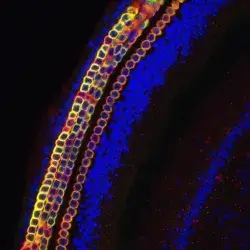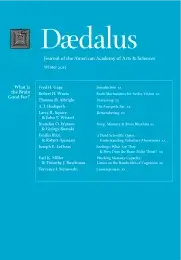
Brain Mechanisms for Active Vision
Active vision refers to the exploration of the visual world with rapid eye movements, or saccades, guided by shifts of visual attention. Saccades perform the critical function of directing the high-resolution fovea of our eyes to any point in the visual field two to three times per second. However, the disadvantage of saccades is that each one disrupts vision, causing significant visual disturbance for which the brain must compensate. Exploring the interaction of vision and eye movements provides the opportunity to study the organization of one of the most complex, yet best-understood, brain systems. Outlining this exploration also illustrates some of the ways in which neuroscientists study neuronal systems in the brain and how they relate this brain activity to behavior. It shows the advantages and limitations of current approaches in systems neuroscience, as well as a glimpse of its potential future.
Perceiving
Perceiving is the process by which evanescent sensations are linked to environmental cause and made enduring and coherent through the assignment of meaning, utility, and value. Fundamental to this process is the establishment of associations over space and time between sensory events and other sources of information. These associations provide the context needed to resolve the inherent ambiguity of sensations. Recent studies have explored the neuronal bases of contextual influences on perception. These studies have revealed systems in the brain through which context converts neuronal codes for sensory events into neuronal representations that underlie perceptual experience. This work sheds light on the cellular processes by which associations are learned and how memory retrieval impacts the processing of sensory information. Collectively, these findings suggest that perception is the consequence of a critical neuronal computation in which contextual information is used to transform incoming signals from a sensory-based to a scene-based representation.
The Energetic Ear
As the gateway to human communication, the sense of hearing is of enormous importance in our lives. Research on hearing has recently been revolutionized by the demonstration that the ear is not simply a passive receiver for sound, but also an amplifier that augments, filters, and compresses its inputs. Hair cells, the ear's sensory receptors, use two distinct methods to implement an active process that endows our hearing with these remarkable properties. First, the vibration-sensitive structures of the ear, called hair bundles, display a mechanical instability that allows them to oscillate in response to stimulation. And second, the membranes of hair cells are replete with proteins that contract in response to electrical stimuli, thus enabling the cells to act like tiny muscles. The activity of these two motile processes can be so exuberant as to cause normal ears to emit sounds.
Remembering
A major development in understanding the structure and organization of memory was the identification of the medial temporal lobe memory system as one of the brain systems that support memory. Work on this topic began in the 1950s with the study of the noted amnesic patient H.M. and culminated in studies of an animal model of human memory impairment in the nonhuman primate. These discoveries opened new frontiers of research concerned with the functional specialization of structures within the medial temporal lobe, the existence of multiple memory systems, the process of memory consolidation, and the role of neural replay and sleep in the consolidation process. This work also led to new insights about how and where memories are ultimately stored in the brain. All of this research has improved our understanding of how memory is affected by normal aging and why it is so profoundly impaired by the pathological processes associated with dementia.
Sleep, Memory & Brain Rhythms
Sleep occupies roughly one-third of our lives, yet the scientific community is still not entirely clear on its purpose or function. Existing data point most strongly to its role in memory and homeostasis: that sleep helps maintain basic brain functioning via a homeostatic mechanism that loosens connections between overworked synapses, and that sleep helps consolidate and re-form important memories. In this review, we will summarize these theories, but also focus on substantial new information regarding the relation of electrical brain rhythms to sleep. In particular, while REM sleep may contribute to the homeostatic weakening of overactive synapses, a prominent and transient oscillatory rhythm called “sharp-wave ripple” seems to allow for consolidation of behaviorally relevant memories across many structures of the brain. We propose that a theory of sleep involving the division of labor between two states of sleep–REM and non-REM, the latter of which has an abundance of ripple electrical activity–might allow for a fusion of the two main sleep theories. This theory then postulates that sleep performs a combination of consolidation and homeostasis that promotes optimal knowledge retention as well as optimal waking brain function.
A Hard Scientific Quest: Understanding Voluntary Movements
In this article we explore the complexities of what goes on in the brain when one wishes to perform even the simplest everyday movements. In doing so, we describe experiments indicating that the spinal cord interneurons are organized in functional modules and that each module activates a distinct set of muscles. Through these modules the central nervous system has found a simple solution to controlling the large number of muscle fibers active even during the execution of the simplest action. We also explore the many different neural signals that contribute to pattern formations, including afferent information from the limbs and information of motor memories.
Feelings: What Are They & How Does the Brain Make Them?
Traditionally, we define “emotions” as feelings and “feelings” as conscious experiences. Conscious experiences are not readily studied in animals. However, animal research is essential to understanding the brain mechanisms underlying psychological function. So how can we make study mechanisms related to emotion in animals? I argue that our approach to this topic has been flawed and propose a way out of the dilemma: to separate processes that control so-called emotional behavior from the processes that give rise to conscious feelings (these are often assumed to be products of the same brain system).
Working Memory Capacity: Limits on the Bandwidth of Cognition
Why can your brain store a lifetime of experiences but process only a few thoughts at once? In this article we discuss “cognitive capacity” (the number of items that can be held “in mind” simultaneously) and suggest that the limit is inherent to processing based on oscillatory brain rhythms, or “brain waves,” which may regulate neural communication. Neurons that “hum” together temporarily “wire” together, allowing the brain to form and re-form networks on the fly, which may explain a hallmark of intelligence and cognition: mental flexibility. But this comes at a cost; only a small number of thoughts can fit into each wave. This explains why you should never talk on a mobile phone when driving.
Consciousness
No one did more to draw neuroscientists’ attention to the problem of consciousness in the twentieth century than Francis Crick, who may be better known as the co-discoverer (with James Watson) of the structure of DNA. Crick focused his research on visual awareness and based his analysis on the progress made over the last fifty years in uncovering the neural mechanisms underlying visual perception. Because much of what happens in our brains occurs below the level of consciousness and many of our intuitions about unconscious processing are misleading, consciousness remains an elusive problem. In the end, when all of the brain mechanisms that underlie consciousness have been identified, will we still be asking: “What is consciousness?” Or will the question shift, just as the question “What is life?” is no longer the same as it was before Francis Crick?
